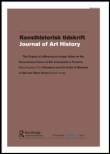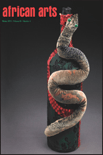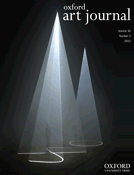
Zbornik Matice Srpske za Likovne Umetnosti-Matica Srpska Journal for Fine Arts
Scope & Guideline
Bridging Theory and Practice in the Fine Arts Landscape
Introduction
Aims and Scopes
- Exploration of Serbian Art History:
The journal delves into various aspects of Serbian art history, including influential artists, movements, and the cultural contexts that shaped them. It seeks to document and analyze the evolution of artistic practices in Serbia over different historical periods. - Architectural Studies:
A significant focus is placed on the architectural heritage of Serbia, examining both historical and contemporary architectural practices. The journal showcases research on prominent architects, significant buildings, and the socio-political influences on architectural styles. - Cultural Heritage and Preservation:
The journal emphasizes the importance of cultural heritage, including discussions on preservation techniques, the role of museums, and the impact of art on national identity. It aims to promote awareness and scholarship surrounding the conservation of artistic and architectural legacies. - Interdisciplinary Approaches:
Research published in the journal often adopts interdisciplinary methodologies, integrating art history, architecture, cultural studies, and even political history to provide a more comprehensive understanding of visual culture in Serbia. - Iconography and Symbolism:
An important aspect of the journal is the study of iconography and symbolism in Serbian visual arts, particularly in religious and historical contexts. This includes analyses of motifs, themes, and their socio-cultural implications.
Trending and Emerging
- Historical Contextualization of Art:
Recent publications increasingly emphasize the historical context of artworks, exploring how political, social, and economic factors have influenced artistic production. This trend reflects a broader scholarly movement toward understanding art as a product of its time. - Architectural Heritage and Identity:
There is a growing interest in the relationship between architectural heritage and national identity, particularly how historical architecture contributes to contemporary cultural narratives. This theme resonates with current discussions on cultural preservation and identity politics. - Interdisciplinary Methodologies:
The use of interdisciplinary approaches is on the rise, with researchers incorporating insights from anthropology, sociology, and history to enrich their analyses of art and architecture. This trend indicates a shift towards more holistic understandings of visual culture. - Iconographic Studies:
A notable increase in studies focusing on iconography and symbolism in Serbian art has emerged, highlighting the importance of visual language and its implications for cultural identity and religious expression. - Art and Politics:
The intersection of art and politics is gaining traction, with more publications exploring how art functions as a medium for political expression and social commentary, particularly in the context of Serbian history.
Declining or Waning
- Contemporary Art Trends:
There appears to be a declining focus on contemporary art movements and their critical analysis within the journal. Fewer papers are addressing current artistic practices or the impact of globalization on Serbian contemporary art. - Modernism and Its Legacy:
Research related to modernist art and architecture, which once held a significant place in the journal, has seen a reduction in frequency. This may indicate a shift towards more historical contexts rather than the exploration of modernist influences. - Gender Studies in Art:
Although gender perspectives in art have been a growing field, the journal has published fewer articles focusing explicitly on gender issues within Serbian art and its historical context, suggesting a possible waning interest in this critical lens. - Regional Artistic Exchanges:
The exploration of regional artistic exchanges within Southeast Europe appears to be less prevalent in recent issues. Fewer papers are discussing the influences and interactions between Serbian artists and their counterparts in neighboring countries.
Similar Journals

KONSTHISTORISK TIDSKRIFT
Nurturing a Vibrant Community of Art HistoriansKONSTHISTORISK TIDSKRIFT is a distinguished journal dedicated to the exploration of art history and its intersections with visual and performing arts. Published by Routledge Journals, Taylor & Francis Ltd, this esteemed publication has been a vital resource for scholars and professionals alike since its inception in 1932, with a mission to advance the understanding of historical and contemporary artistic expression. Operating from the United Kingdom, it currently occupies a commendable Q3 Quartile ranking in both History and Visual Arts and Performing Arts categories for 2023, according to Scopus metrics. With an engaging array of peer-reviewed articles, the journal serves as a platform for critical discourse, fostering an inclusive intellectual community. As it looks ahead to its convergence into 2024, KONSTHISTORISK TIDSKRIFT promises to enrich the academic landscape with impactful research and insights, making it a vital resource for researchers, professionals, and students passionate about the field.

Umeni-Art
Advancing Knowledge in the Visual and Performing ArtsUmeni-Art is a prominent journal in the field of visual arts and performing arts, published by the Institute of Art History, Academy of Sciences, Czech Republic. With its ISSN 0049-5123 and E-ISSN 1804-6509, the journal has established itself as a critical platform for scholarly discourse and artistic expression since its inception in 2002. Although currently classified in Q4 within the Arts and Humanities category, it aims to elevate the understanding and appreciation of the arts through rigorous research and innovative perspectives. The journal's Scopus ranking places it at Rank #573/667, reflecting its growing contribution to the field and expanding reach within the artistic community. With a focus on fostering collaboration among researchers, practitioners, and students, Umeni-Art seeks to enrich the academic landscape with significant findings and discussions that inspire future research and creative endeavors. While it does not offer open access, the journal remains a valuable resource for those vested in exploring the dynamic interplay between art, culture, and society in the contemporary context.

Zivot Umjetnosti
Cultivating scholarly voices in visual and performing arts.Zivot Umjetnosti, published by the INST POVIJEST UMJETNOSTI - INST ART HISTORY, is a notable Croatian journal that serves as a platform for scholarly discourse in the fields of visual arts, performing arts, and museology. With its inception in 2008, the journal has continued to provide a voice for researchers and practitioners alike, contributing significantly to ongoing conversations in the arts. Despite its current Q4 rank in both Visual Arts and Museology categories—placing it within the 21st and 17th percentiles, respectively—Zivot Umjetnosti is recognized for its commitment to advancing knowledge and fostering critical dialogue. The journal aims to bridge theoretical frameworks with practical applications, making it an invaluable resource for academics, curators, and students engaged in artistic research. While currently operating under traditional access options, Zivot Umjetnosti remains a fundamental publication for those wishing to explore and expand their understanding of the dynamic intersection of art and culture in Croatia and beyond.

Kunstiteaduslikke Uurimusi
Advancing Knowledge in Arts and HumanitiesKunstiteaduslikke Uurimusi is a notable academic journal published by the Estonian Society Art Historians, dedicated to the exploration and analysis of art and cultural studies within the vibrant context of Estonia and beyond. With an ISSN of 1406-2860, this journal offers a platform for researchers, professionals, and students to disseminate their findings and engage in meaningful discourse in the fields of Arts and Humanities and Cultural Studies. Although it occupies a fourth quartile ranking in both fields, the journal's commitment to fostering scholarly dialogue is evident through its open access provision, facilitating the sharing of knowledge across disciplines. Covering a broad spectrum of art historical themes since its inception, Kunstiteaduslikke Uurimusi aims to contribute to the understanding of artistic practices and cultural phenomena, making it an essential resource for those interested in the intersections of art, culture, and society. The journal continues to evolve, with coverage extending from 2011 to 2024, reflecting the dynamic nature of the arts and cultural sectors.

Codex Aquilarensis
Unveiling the Depths of Historical and Artistic ScholarshipCodex Aquilarensis is a distinguished academic journal published by FUNDACION SANTA MARIA REAL, CENTRO ESTUDIOS ROMANICO, specializing in History and Visual Arts and Performing Arts. With an ISSN of 0214-896X and an E-ISSN of 2386-6454, this journal has carved its niche within the scholarly community in Spain, encompassing a range of topics pertinent to its fields of study. Although it currently holds a Q4 category in both History and Visual Arts and Performing Arts as of 2023, it plays a critical role in disseminating important research and insights from 2015 to 2022, contributing to the academic dialogue around these disciplines. While access options are limited, the journal's commitment to enhancing understanding in the arts and humanities makes it a valuable resource for researchers, professionals, and students alike. Its ranking within Scopus further underscores its relevance, positioning it within the competitive landscape of arts and humanities research. Scholars and practitioners interested in historical and artistic studies are encouraged to engage with the content presented by Codex Aquilarensis as it continues to evolve and contribute to the intellectual heritage of the region.

Eidola-International Journal of Classical Art History
Cultivating Critical Insights in Classical Art Studies.Eidola - International Journal of Classical Art History, published by Fabrizio Serra Editore, is dedicated to exploring the intricate connections between classical art and history. With an ISSN of 1824-6192 and an E-ISSN of 1826-719X, this journal stands as a pivotal resource for researchers, academics, and students within the realms of Classics, Visual Arts, and Performing Arts. Despite its recent establishment, having converged in the years 2019 to 2023, Eidola has carved out a place in various category quartiles, specifically achieving Q3 in Classics and Visual Arts and Q4 in History for 2023, indicating its growing influence in the field. Its Scopus rankings (Rank #163/170 in Classics and Rank #638/667 in Visual Arts and Performing Arts) further reflect its contribution to scholarly discourse, albeit in a competitive landscape. Though not openly accessible, the publication prioritizes substantial research, original scholarship, and critical reviews that enhance the understanding of classical art within broader historical contexts. For anyone invested in the dialogues surrounding art history, Eidola presents a vital avenue for engagement and scholarly exploration.

Quiroga-Revista de Patrimonio Iberoamericano
Exploring the Rich Tapestry of Ibero-American Arts and ConservationQuiroga-Revista de Patrimonio Iberoamericano, published by UNIV GRANADA, is a distinguished open-access journal dedicated to the fields of conservation, museology, and the visual and performing arts. Since its inception in 2012, the journal has provided a platform for scholars and practitioners to disseminate innovative research and critical discussions pertinent to Ibero-American heritage. With a growing impact, evidenced by its category quartiles ranking—Q3 in Conservation and Q2 in both Museology and Visual Arts and Performing Arts—as well as its Scopus rankings, Quiroga serves as an essential resource for researchers, professionals, and students who engage with the complexities of cultural preservation and artistic expression. The journal’s commitment to open access ensures the widespread availability of knowledge, fostering academic dialogue and collaboration within the global community. For inquiries, the journal can be reached at their offices located in Granada, Spain.

AFRICAN ARTS
Diving into the Heartbeat of African CreativityAFRICAN ARTS is a distinguished journal published by MIT PRESS, focusing on the vibrant intersections of literature, visual arts, and performing arts within the African context. Boasting an ISSN of 0001-9933 and an E-ISSN of 1937-2108, this journal serves as a critical platform for scholars and practitioners worldwide to explore and disseminate their research on African artistic expressions. With a solid impact represented by its Q3 rankings in both Literature and Literary Theory and Visual Arts and Performing Arts as of 2023, it ranks in the top 20% within the literature category and in the top 30% for visual arts. AFRICAN ARTS aims to foster a deeper understanding of the cultural, historical, and social contexts that shape these disciplines, embracing a wide array of methodologies and theoretical frameworks. Though not an open-access journal, it provides valuable insights and analysis that contribute significantly to the global discourse surrounding African arts, making it a vital resource for researchers, professionals, and students alike.

OXFORD ART JOURNAL
Enriching Academic Conversations in Art StudiesOxford Art Journal, published by Oxford University Press, serves as a vital platform for scholarly discourse in the fields of History, Visual Arts, and Performing Arts. With an ISSN of 0142-6540 and an E-ISSN of 1741-7287, this esteemed journal has cultivated a rich academic presence since its inception, reflecting a deep commitment to exploring the intricacies of art history and contemporary visual culture. Holding a Q2 ranking in Visual Arts and Performing Arts and a Q3 ranking in History for the year 2023, the journal features rigorous peer-reviewed articles that push the boundaries of research and offer new insights into artistic practices. Although not offering open access, the journal is widely respected for its contributions to the academic community, making it invaluable for researchers, professionals, and students deeply engaged in art studies. For those seeking a comprehensive understanding of the visual arts landscape, the Oxford Art Journal remains an indispensable resource.

Lino - Revista Anual de Historia del Arte
Fostering Scholarly Excellence in Visual ArtsLino - Revista Anual de Historia del Arte is a distinguished journal dedicated to advancing scholarly research in the fields of History and Visual Arts. Published by UNIV OVIEDO in Spain, this annual publication has been fostering academic dialogue since its inception in 2012 and continues to enrich the scholarly landscape through 2024. With its ISSN 0211-2574 and E-ISSN 2341-1139, the journal serves as an accessible repository for critical insights and innovative perspectives. As a member of the Q3 category in both History and Visual Arts and Performing Arts, it is poised to contribute significantly to ongoing discussions in these areas, despite its current standing in Scopus rankings. Lino's mission is to promote a deeper understanding of art history through rigorous research and high-quality publications that resonate with researchers, professionals, and students alike. The journal's commitment to scholarly excellence ensures that it remains a vital source of knowledge for those invested in the dynamic intersection of visual culture and historical analysis.